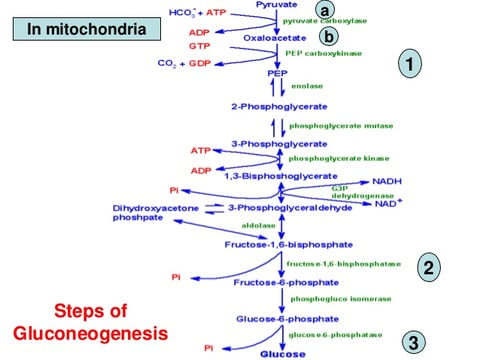GLUCONEOGENESIS
Process of gluconeogenesis , where the body creates glucose from scratch! Learn how this vital metabolic pathway helps regulate blood sugar levels, and its crucial role in maintaining energy homeostasis. Discover the key players, steps, and regulation of gluconeogenesis, and how it impacts diabetes, fasting, and overall health.
CARBOHYDRATE METABOLISM
GLUCONEOGENESIS
⭐Gluconeogenesis is the synthesis of glucose from non-carbohydrate compounds.
⭐The major substrates for gluconeogenesis are lactate, pyruvate, glycerol, amino acids, propionate, and alanine.
⭐Gluconeogenesis primarily occurs in the liver, with some contribution from the kidneys.
Steps of Gluconeogenesis:
1.Conversion of Pyruvate to Phosphoenolpyruvate (PEP):
•Pyruvate is converted to oxaloacetate by pyruvate carboxylase in the mitochondria.
•Oxaloacetate is then converted to malate, which is transported to the cytoplasm.
•Malate is converted back to oxaloacetate, which is further converted to PEP by PEP carboxykinase (PEPCK).
2.Conversion of Glycerol to Dihydroxyacetone Phosphate (DHAP):
•Glycerol is converted to DHAP, which can be converted to glucose or used in glycolysis.
3.PEP to fructose-1, 6-bisphosphate:-
•Enzymatically, phosphoenol pyruvate (PEP) is converted to fructose 1,6-bisphosphate.
•PEP carboxykinase converts PEP to oxaloacetate, which is then converted to malate and transposed to the cytoplasm.
•Malate is phosphorylated to regenerate PEP.
3.Conversion of Fructose 1,6-Bisphosphate to Glucose:
•Fructose 1,6-bisphosphate is converted to glucose by removing the phosphate group.-
-This step avoids irreversible glycolysis event.
-It is mainly present in liver and kidney.
Number Represent The Entry Of Glucogenic Amino Acids:
Alanine, Glycine, Serine, Cysteine, Threonine, Tryptophan,
Aspartate, Arginine,
Histidine, Proline Leucine, Glutamate, glutamine
Methionine, Valine ,Isoleucine
Phenylalanine, Tyrosine
Regulation of Gluconeogenesis
1.Influence of Glucagon Hormone:
✹Glucagon is secreted by alpha-cells in the pancreatic islets.
✹Stimulates gluconeogenesis through two mechanisms.
2.Regulation Mechanisms:
a)Pyruvate Kinase Regulation:
✹Pyruvate kinase is inhibited via cyclic AMP.
✹Reduced pyruvate kinase activity directs pyruvate towards glucose synthesis (gluconeogenesis).
b)Fructose 2,6-Bisphosphate Control:
✹Glucagon decreases fructose 2,6-bisphosphate levels.
✹Normally activates glycolysis; decreased levels favor increased gluconeogenesis.
3.Substrate Availability:
✹Glucogenic amino acids stimulate gluconeogenesis.
✹Important in conditions like diabetes mellitus where amino acids are mobilized from muscle protein for glucose production.
4.Acetyl CoA and Enhanced Gluconeogenesis:
✹During fasting or elevated lipolysis, excess acetyl CoA accumulates in the liver.
✹Enhances gluconeogenesis by allosteric activation of pyruvate carboxylase, aiding in maintaining blood glucose levels.


Engage with Us:
Stay tuned for more captivating insights and News. Visit our Blogs and Follow Us on social media to never miss an update. Together, let's unravel the mysteries of the natural world.
